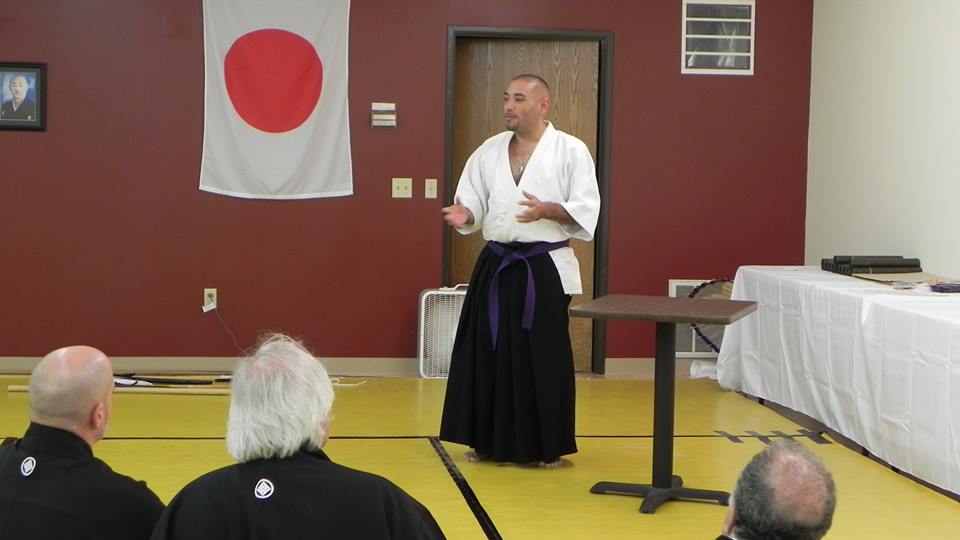Hakko Ryu Jujutsu
Hakko-Ryu JuJutsu was Founded in 1941, it inherits a centuries-old legacy of classical bujutsu (Warrior Arts) used by samurai of feudal Japan. by Ryuho Okuyama (1901 – 1987) and his son Nidai Soke Ryuho (Toshio) Okuyama who come from a long line of prominent bushi (warriors). As a student of Hakko-Ryu you can trace the origins of your art as far back as the eight Centaury A.D.
We are Hakko-RyuSenshinkan Dojo (Pure-Heart School) instructed by Menkyo Kaiden Sandaikichu Shihan Joseph ‘Kozan’ (Social Mountain) Stricker.
Koho Shiatsu
While Hakkoryu applies pressure techniques on Keiraku to defend oneself or pin down an opponent when one is being attacked, applying pressure techniques on Keiraku is also the essential theory of Koho Shiatsu.
In Hakkoryu, one is learning a martial art while at the same time practicing Shiatsu techniques. Koho Shiatsu, as a solid therapeutic method, is perfectly complementary to the techniques of Hakkoryu, as a martial art.
Shodai Soke Okuyama Ryuho, the founder of Hakkoryu Jujutsu and Hakkoryu Koho Shiatsu, established the final methods for both systems. He was also an active member of political parties whose aim was to reform Japanese society from decline and improve very difficult social conditions.
He was born in Yamagata Prefecture in 1901. When he was five years old, he contracted meningitis and suffered a great deal. He miraculously recovered from the illness with the ancient treatments of traditional oriental medicine. After this experience, he took a strong interest in oriental medical theory and practice.
After graduation from the Tokyo School of Government, he moved to Hokkaido, the northern island, where amongst his numerous political activities, he founded and managed a shiatsu clinic. During this period, he traveled widely and studied traditional oriental medicine and martial arts seriously and enthusiastically from numerous pre-eminent teachers.
After many years of medical study, he achieved a high level of mastery of traditional oriental medicine and established a private school he named, “Koho Gijuku”, to teach traditional medicine in Asahikawa City, Hokkaido during the early Showa period. He became famous through his efforts and was able to train many therapists at his school. He also was engaged in many public lectures within the city. Around 1932, he was inaugurated as the President of the Asahikawa Therapist Association because of his high skill, knowledge, and dedication to traditional oriental medicine.
Shodai Soke Okuyama Ryuho eventually completed establishing his own styles of self-protection and medical methods and techniques, which were both very unique and effective, calling his systems, “Koho Shiatsu” and “Hakkoryu Jujutsu”.
Before the end of World War II, he moved to his native Yamagata Prefecture, staying at Hagurosan (Mt. Haguro) where Shinto priests and ascetics (the Mt. Haguro Shugendo sect) meditate and study at the Hagurosan Shrine. During this period in the mountains of Haguro, Shodai Soke diligently studied, and continued to sharpen the techniques of Hakkoryu Jujutsu and Koho Shiatsu.
In 1947, following the end of the War, Shodai Soke moved again and established his private school, the Hakko Juku Hombu Dojo, in Omiya City (now known as Saitama City), Saitama Prefecture. He began again teaching Hakkoryu Jujutsu and Koho Shiatsu on a regular basis.
The prominent feature of Hakkoryu Jujutsu is to totally abandon physical power, to relax completely, and then apply techniques to opponents in order to defend oneself. Most other martial arts commonly aim to defeat or destroy an opponent, but Hakkoryu’s exponents, while completely relaxed, uses the attacker’s force and strikes a vital point on Keiraku to instantly freeze, stop, pin down, and/or control the movement of the opponent. As most everyone knows, in a Judo match, a physically smaller person experiences great difficulty in winning a match if he encounters an opponent of much larger size. Hakkoryu has no problem with such physical differences. In Hakkoryu, gentle, swift, and efficient maneuvers reign supreme over hardness, strength and body size.


